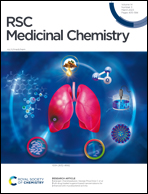Host–guest binding of tetracationic cyclophanes to photodynamic agents inhibits posttreatment phototoxicity and maintains antitumour efficacy†
Abstract
In the past two decades, photodynamic therapy (PDT) has become an effective method for the treatment of cancer. However, the posttreatment residue of photodynamic agents (PDAs) causes long-term skin phototoxicity. Here, we apply naphthalene-derived, box-like tetracationic cyclophanes, named NpBoxes, to bind to clinically used porphyrin-based PDAs to alleviate their posttreatment phototoxicity by reducing their free content in skin tissues and 1O2 quantum yield. We show that one of the cyclophanes, 2,6-NpBox, could include the PDAs to efficiently suppress their photosensitivity for the generation of reactive oxygen species. A tumour-bearing mouse model study revealed that, when Photofrin, the most widely used PDA in clinic, was administrated at a dose corresponding to the clinical one, 2,6-NpBox of the same dose could significantly suppress its posttreatment phototoxicity on the skin induced by simulated sunlight irradiation, without imposing a negative influence on its PDT efficacy.



 Please wait while we load your content...
Please wait while we load your content...